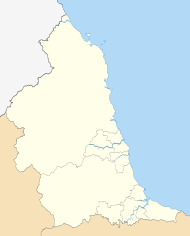User:CSJJ104/sandbox/Second Bishops' War
| This is not a Wikipedia article: It is an individual user's work-in-progress page, and may be incomplete and/or unreliable. For guidance on developing this draft, see Wikipedia:So you made a userspace draft. Find sources: Google (books · news · scholar · free images · WP refs) · FENS · JSTOR · TWL |
New article name goes here new article content ...
Background
[edit]Opposing forces
[edit]Covenanters
[edit]Royalists
[edit]Campaigns
[edit]Campaign in Scotland
[edit]Newburn campaign
[edit]Leslie joined the Covenanter army at Duns in July, as the build up along the border neared completion. Seeing the English forces opposing him were in no state to take offensive action Leslie led his men over the Tweed on 20 August and continued south without encountering opposition, reaching the Tyne at Newburn. After a short encounter at Newburn on 28 August the English forces fled, leaving Leslie free to attack Newcastle from the rear where it was less well defended. The English garrison withdrew without a fight, allowing Leslie to enter Newcastle on 30 August.[1]
After taking Newcastle, Leslie sent Charles Seton to seize Durham, a task accomplished on 4 September. The Covenanters would advance as far as the Tweed, where they established a line of outposts by 18 September, before pausing to allow negotiations to proceed.[2] The Treaty of Ripon would be agreed on 28 October,[1] allowing the Covenanters to remain in control of Northumberland and Durham and requiring the English to pay them £850 a day to cover their expenses, while the dispute was referred to the English Parliament.[3]
Aftermath
[edit]Charles issued writs for a parliament which met on 3 November and would become known as the Long Parliament. Since the Scots had made clear they would not return home until they were paid and had agreed a settlement with the English Parliament, this parliament was the first for centuries that the king was unable to dissolve at will.[4] One of the parliament's first acts was to deny Charles funds to continue fighting the Scots, who were allowed to run their Church as they liked.[3]
The Long Parliament would then pass acts meaning it could not be dissolved without its own permission, executed Strafford, and imprisoned Archbishop Laud.[5] Parliament agreed the Treaty of London, signed on 10 August, paying the Scots £300,000 as recompense for the wars.[6] Following this, the Covenanter army returned to Scotland on 7 September.[7]
Disputes between Charles and Parliament continued to escalate, culminating in the attempted arrest of the Five Members in January 1642. Charles left London and began rallying support for his cause, raising his standard on 22 August 1642, beginning the English Civil War.[4]
References
[edit]- ^ a b Stevenson 2007.
- ^ Gericke 2001.
- ^ a b Matthews 2003.
- ^ a b Kishlansky & Morrill 2008.
- ^ Helicon 2018.
- ^ Plant 2010.
- ^ Kenyon & Ohlmeyer 1998a, p. 28.
Sources
[edit]- Asch, Ronald G. (2009). "Wentworth, Thomas, first earl of Strafford". Oxford Dictionary of National Biography (online ed.). Oxford University Press. doi:10.1093/ref:odnb/29056. (Subscription or UK public library membership required.)
- Furgol, Edward (1998). "The Civil Wars in Scotland". In Kenyon, John; Ohlmeyer, Jane (eds.). The Civil Wars: A Military History of England, Scotland, and Ireland 1638-1660. Oxford University Press. ISBN 0-19-866222-X.
- Gericke, Bradley T (2001). Civil Wars in Britain; 1640-1646 (PDF) (PhD). U.S. Army Command and General Staff College.
- Helicon (2018). "The Hutchinson Unabridged Encyclopedia with Atlas and Weather Guide". search.credoreference.com. Why was there a civil war in England in 1642?: Helicon - Credo Reference. Retrieved 6 October 2020.
{{cite web}}: CS1 maint: location (link) - Kenyon, John; Ohlmeyer, Jane (1998a). "The Background to the Civil Wars in the Stuart Kingdoms". In Kenyon, John; Ohlmeyer, Jane (eds.). The Civil Wars: A Military History of England, Scotland, and Ireland 1638-1660. Oxford University Press. ISBN 0-19-866222-X.
- Kenyon, John; Ohlmeyer, Jane (1998b). "Chronology". In Kenyon, John; Ohlmeyer, Jane (eds.). The Civil Wars: A Military History of England, Scotland, and Ireland 1638-1660. Oxford University Press. ISBN 0-19-866222-X.
- Kishlansky, Mark A; Morrill, John (2008). "Charles I (1600–1649)". Oxford Dictionary of National Biography (online ed.). Oxford University Press. doi:10.1093/ref:odnb/5143. (Subscription or UK public library membership required.)
- Macinnes, Allan I. (15 July 2014). "Covenanting Exchanges with the French Court during the Wars for the Three Kingdoms". E-rea. Revue électronique d'études sur le monde anglophone. 11 (2). doi:10.4000/erea.3678. ISSN 1638-1718. Retrieved 3 October 2020.
- Matthews, Rupert (2003). England Versus Scotland: Great British Battles. Newburn Ford 1640: Leo Cooper. ISBN 978-0850529494.
{{cite book}}: CS1 maint: location (link) - Plant, David (24 November 2010). "The Treaty of London, 1641". bcw-project.org. BCW Project. Retrieved 11 September 2020.
- Stevenson, David (2006). "Campbell, Archibald, marquess of Argyll". Oxford Dictionary of National Biography (online ed.). Oxford University Press. doi:10.1093/ref:odnb/4472. (Subscription or UK public library membership required.)
- Stevenson, David (2007). "Leslie, Alexander, first earl of Leven". Oxford Dictionary of National Biography (online ed.). Oxford University Press. doi:10.1093/ref:odnb/16482. (Subscription or UK public library membership required.)
- Young, John (2001). "Covenant, Wars of the". The Oxford Companion to Scottish History. Oxford University Press. doi:10.1093/acref/9780199234820.001.0001. ISBN 9780199234820. Retrieved 3 October 2020.
- Young, John (October 2013). "Scotland and Ulster connections in the seventeenth century : Sir Robert Adair of Kinhilt and the Scottish Parliament under the covenanters". Journal of Scotch-Irish Studies. 3 (4): 16–76. ISSN 1535-9840. Retrieved 3 October 2020.
External links
[edit]


